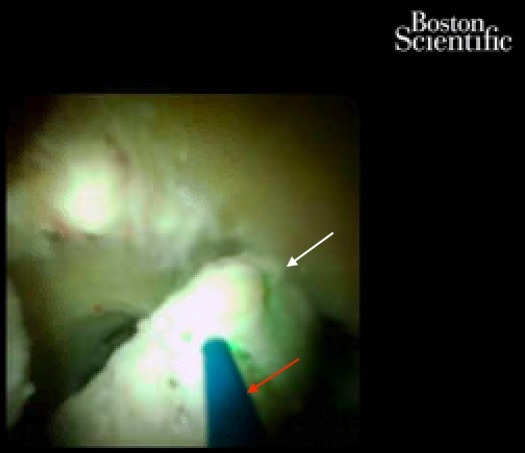Back
Poster Session E - Tuesday Afternoon
E0084 - ERCP With Per-Oral Pancreatoscopy-Guided Laser Lithotripsy for Difficult Pancreatic Duct Stones
Tuesday, October 25, 2022
3:00 PM – 5:00 PM ET
Location: Crown Ballroom

Nichole Henkes
University of Texas Health San Antonio
San Antonio, TX
Presenting Author(s)
Nichole Henkes, , Peter M. Stawinski, MD, Karolina N. Dziadkowiec, MD, Natasha McMillan, MD, Laura Rosenkranz, MD
University of Texas Health San Antonio, San Antonio, TX
Introduction: Endoscopic retrograde cholangiopancreatography (ERCP) with sphincterotomy and balloon/basket extraction is the first line management for symptomatic pancreatic duct (PD) stones. The risk of stone extraction failure via ERCP increases with PD stones that are >10mm, impacted, multiple stones or in a complicated location [1]. With difficult PD stones, fragmentation prior to extraction may be required. Stone fragmentation can be accomplished through extracorporeal shock wave lithotripsy (ESWL), per-oral pancreatoscopy (POP) laser lithotripsy (LL) and POP- electrohydraulic lithotripsy (EHL). We report a case of difficult PD stones successfully managed by POP-LL holmium laser.
Case Description/Methods: A 48-year-old man with advanced primary sclerosing cholangitis with percutaneous biliary drainage and chronic pancreatitis presented for recurrent jaundice, right upper quadrant and midepigastric abdominal pain and pruritus.
ERCP revealed the ventral PD filled with numerous stones and was swept with a balloon and 1 stone was removed. Repeat ERCP was performed 2 weeks later with balloon extraction of a few small stones and debris from the PD. The ventral duct was then explored under pancreatoscopy using Spyglass, revealing multiple stones in the head and neck of the pancreas. Lithotripsy was then accomplished using a holmium laser. No immediate nor distant post-ERCP complications were encountered. A 1-week follow up revealed resolution of abdominal pain.
Discussion: The patient in our case had recurrent abdominal pain caused by pancreatic duct stones resulting in pancreatic outflow obstruction. Both attempts using ERCP with balloon sweeping were unsuccessful in complete stone extraction leading to the use of POP Spyglass with laser lithotripsy for the management of the multiple remaining stones. Direct visualization of the PD with technology like Spyglass, has shown to reduce the risk of duct injury, allows the visualization of stones that may have been missed previously, and permits confirmation of clearance of the PD. As seen in this case, POP allowed for visualization of PD stones that could not be accessed through ERCP management and used in conjunction with laser lithotripsy, the PD stones were successfully and safely fragmented. POP-LL has been shown to successfully fragment difficult to manage PD stones, as evidenced in this case and other studies, and should be considered as a useful alternative in the management of numerous PD stones and/or multiple unsuccessful ERCP attempts.

Disclosures:
Nichole Henkes, , Peter M. Stawinski, MD, Karolina N. Dziadkowiec, MD, Natasha McMillan, MD, Laura Rosenkranz, MD. E0084 - ERCP With Per-Oral Pancreatoscopy-Guided Laser Lithotripsy for Difficult Pancreatic Duct Stones, ACG 2022 Annual Scientific Meeting Abstracts. Charlotte, NC: American College of Gastroenterology.
University of Texas Health San Antonio, San Antonio, TX
Introduction: Endoscopic retrograde cholangiopancreatography (ERCP) with sphincterotomy and balloon/basket extraction is the first line management for symptomatic pancreatic duct (PD) stones. The risk of stone extraction failure via ERCP increases with PD stones that are >10mm, impacted, multiple stones or in a complicated location [1]. With difficult PD stones, fragmentation prior to extraction may be required. Stone fragmentation can be accomplished through extracorporeal shock wave lithotripsy (ESWL), per-oral pancreatoscopy (POP) laser lithotripsy (LL) and POP- electrohydraulic lithotripsy (EHL). We report a case of difficult PD stones successfully managed by POP-LL holmium laser.
Case Description/Methods: A 48-year-old man with advanced primary sclerosing cholangitis with percutaneous biliary drainage and chronic pancreatitis presented for recurrent jaundice, right upper quadrant and midepigastric abdominal pain and pruritus.
ERCP revealed the ventral PD filled with numerous stones and was swept with a balloon and 1 stone was removed. Repeat ERCP was performed 2 weeks later with balloon extraction of a few small stones and debris from the PD. The ventral duct was then explored under pancreatoscopy using Spyglass, revealing multiple stones in the head and neck of the pancreas. Lithotripsy was then accomplished using a holmium laser. No immediate nor distant post-ERCP complications were encountered. A 1-week follow up revealed resolution of abdominal pain.
Discussion: The patient in our case had recurrent abdominal pain caused by pancreatic duct stones resulting in pancreatic outflow obstruction. Both attempts using ERCP with balloon sweeping were unsuccessful in complete stone extraction leading to the use of POP Spyglass with laser lithotripsy for the management of the multiple remaining stones. Direct visualization of the PD with technology like Spyglass, has shown to reduce the risk of duct injury, allows the visualization of stones that may have been missed previously, and permits confirmation of clearance of the PD. As seen in this case, POP allowed for visualization of PD stones that could not be accessed through ERCP management and used in conjunction with laser lithotripsy, the PD stones were successfully and safely fragmented. POP-LL has been shown to successfully fragment difficult to manage PD stones, as evidenced in this case and other studies, and should be considered as a useful alternative in the management of numerous PD stones and/or multiple unsuccessful ERCP attempts.

Figure: Laser lithotripsy with holmium laser being applied through the catheter (red arrow) to the PD stone (white arrow).
Disclosures:
Nichole Henkes indicated no relevant financial relationships.
Peter Stawinski indicated no relevant financial relationships.
Karolina Dziadkowiec indicated no relevant financial relationships.
Natasha McMillan indicated no relevant financial relationships.
Laura Rosenkranz indicated no relevant financial relationships.
Nichole Henkes, , Peter M. Stawinski, MD, Karolina N. Dziadkowiec, MD, Natasha McMillan, MD, Laura Rosenkranz, MD. E0084 - ERCP With Per-Oral Pancreatoscopy-Guided Laser Lithotripsy for Difficult Pancreatic Duct Stones, ACG 2022 Annual Scientific Meeting Abstracts. Charlotte, NC: American College of Gastroenterology.
